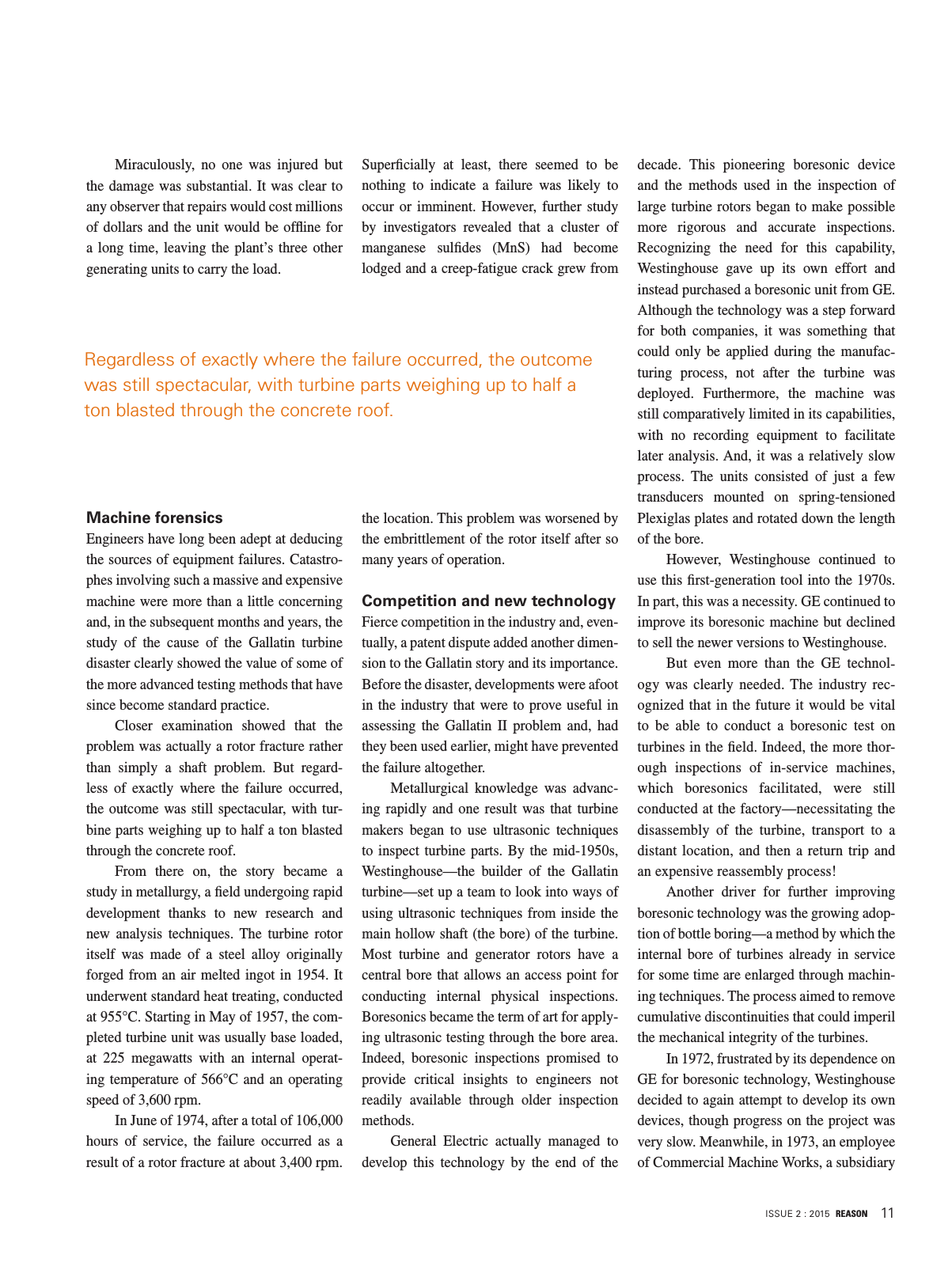Miraculously no one was injured but the damage was substantial It was clear to any observer that repairs would cost millions of dollars and the unit would be offline for a long time leaving the plant s three other generating units to carry the load Machine forensics Engineers have long been adept at deducing the sources of equipment failures Catastro phes involving such a massive and expensive machine were more than a little concerning and in the subsequent months and years the study of the cause of the Gallatin turbine disaster clearly showed the value of some of the more advanced testing methods that have since become standard practice Closer examination showed that the problem was actually a rotor fracture rather than simply a shaft problem But regard less of exactly where the failure occurred the outcome was still spectacular with tur bine parts weighing up to half a ton blasted through the concrete roof From there on the story became a study in metallurgy a field undergoing rapid development thanks to new research and new analysis techniques The turbine rotor itself was made of a steel alloy originally forged from an air melted ingot in 1954 It underwent standard heat treating conducted at 955 C Starting in May of 1957 the com pleted turbine unit was usually base loaded at 225 megawatts with an internal operat ing temperature of 566 C and an operating speed of 3 600 rpm In June of 1974 after a total of 106 000 hours of service the failure occurred as a result of a rotor fracture at about 3 400 rpm Superficially at least there seemed to be nothing to indicate a failure was likely to occur or imminent However further study by investigators revealed that a cluster of manganese sulfides MnS had become lodged and a creep fatigue crack grew from the location This problem was worsened by the embrittlement of the rotor itself after so many years of operation Competition and new technology Fierce competition in the industry and even tually a patent dispute added another dimen sion to the Gallatin story and its importance Before the disaster developments were afoot in the industry that were to prove useful in assessing the Gallatin II problem and had they been used earlier might have prevented the failure altogether Metallurgical knowledge was advanc ing rapidly and one result was that turbine makers began to use ultrasonic techniques to inspect turbine parts By the mid 1950s Westinghouse the builder of the Gallatin turbine set up a team to look into ways of using ultrasonic techniques from inside the main hollow shaft the bore of the turbine Most turbine and generator rotors have a central bore that allows an access point for conducting internal physical inspections Boresonics became the term of art for apply ing ultrasonic testing through the bore area Indeed boresonic inspections promised to provide critical insights to engineers not readily available through older inspection methods General Electric actually managed to develop this technology by the end of the decade This pioneering boresonic device and the methods used in the inspection of large turbine rotors began to make possible more rigorous and accurate inspections Recognizing the need for this capability Westinghouse gave up its own effort and instead purchased a boresonic unit from GE Although the technology was a step forward for both companies it was something that could only be applied during the manufac turing process not after the turbine was deployed Furthermore the machine was still comparatively limited in its capabilities with no recording equipment to facilitate later analysis And it was a relatively slow process The units consisted of just a few transducers mounted on spring tensioned Plexiglas plates and rotated down the length of the bore However Westinghouse continued to use this first generation tool into the 1970s In part this was a necessity GE continued to improve its boresonic machine but declined to sell the newer versions to Westinghouse But even more than the GE technol ogy was clearly needed The industry rec ognized that in the future it would be vital to be able to conduct a boresonic test on turbines in the field Indeed the more thor ough inspections of in service machines which boresonics facilitated were still conducted at the factory necessitating the disassembly of the turbine transport to a distant location and then a return trip and an expensive reassembly process Another driver for further improving boresonic technology was the growing adop tion of bottle boring a method by which the internal bore of turbines already in service for some time are enlarged through machin ing techniques The process aimed to remove cumulative discontinuities that could imperil the mechanical integrity of the turbines In 1972 frustrated by its dependence on GE for boresonic technology Westinghouse decided to again attempt to develop its own devices though progress on the project was very slow Meanwhile in 1973 an employee of Commercial Machine Works a subsidiary Regardless of exactly where the failure occurred the outcome was still spectacular with turbine parts weighing up to half a ton blasted through the concrete roof ISSUE 2 2015 REASON 11

Hinweis: Dies ist eine maschinenlesbare No-Flash Ansicht.
Klicken Sie hier um zur Online-Version zu gelangen.
Klicken Sie hier um zur Online-Version zu gelangen.